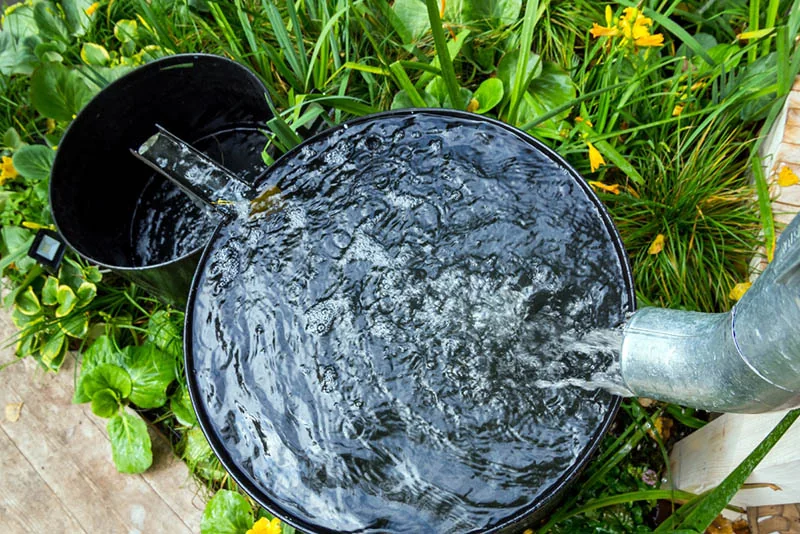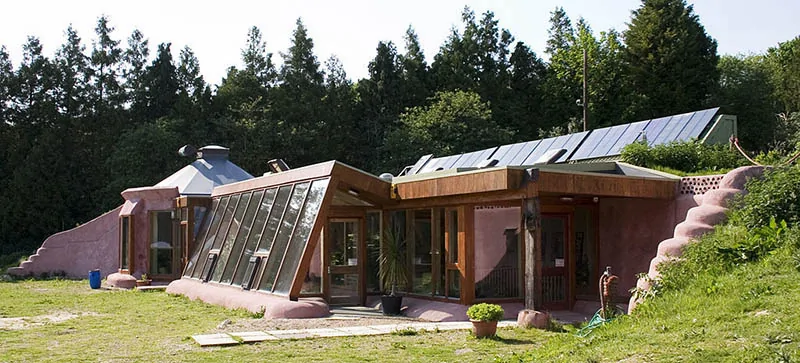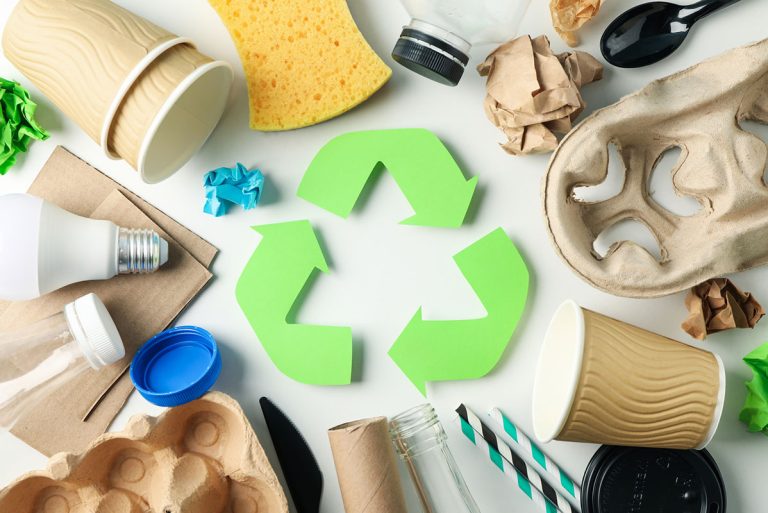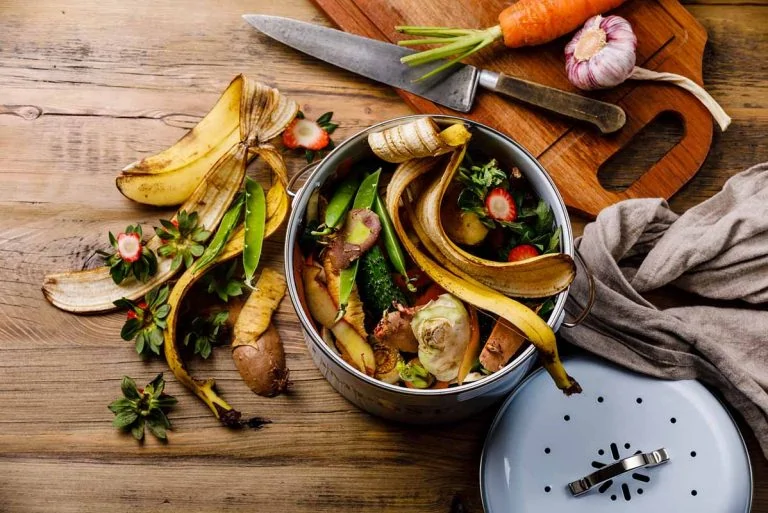Rainwater is a precious natural resource freely available for collection and use. In parts of the world where a municipal water supply is available, neglecting the water that falls from the skies is easy. But rising water rates and fears of water scarcity are causing many householders to consider the benefits of rainwater harvesting for their property.
There are many rainwater harvesting benefits; collecting rainwater for household use can make houses and communities more sustainable and reduce pressure on the municipal water supply. This article explains rainwater harvesting and shares 15 key benefits of this water collection technique.
What is rainwater harvesting?
Rainwater harvesting is simply collecting rainwater for use at home or in industry. People harvest rainwater using anything from a simple container, to a sophisticated installation that channels water into dedicated cisterns.
Rather than being absorbed into the ground or becoming surface run-off, the rainwater is directed using sloped surfaces, channels, and gravity into the storage location. For most properties, the roof of the building provides a large surface area for intercepting and channeling rain.

Collecting rainwater can occur at scale, with massive installations providing a large surface area for collections. Regions with flooded forests, sunken basins, or reservoirs can capture large volumes of water from heavy seasonal rains for community use.
Rainwater harvesting also includes systems to collect dew, fog, and mists using nets and condensing devices. Collected water can be stored for use in tanks, cisterns, pits, boreholes, wells, and reservoirs.
Rainwater harvesting has been a feature of almost every major civilization
Rainwater collection is an ancient practice that goes back millennia. There is archaeological evidence of this practice taking place in the Neolithic Age, and rainwater cisterns have been used by the Ancient Egyptians, Minoans, Babylonians, Greeks, Romans, and Ancient Timbuktu.
How is harvested rainwater used?
Collected rainwater can be used as a water source for any daily activities that require water. Depending on location and the available infrastructure or plumbing, we can use rainwater for:
- Drinking water
- Laundry
- Personal care
- Household cleaning
- Toilet flushing
- Irrigation
- Gardening
- Replenishment of reservoirs and groundwater supplies
15 rainwater harvesting benefits
Rainwater harvesting is a great way of taking advantage of a freely available natural resource. Even the simplest rainwater collection systems can have many benefits for households. Here are 15 need-to-know advantages of collecting rainwater:
1. Rainwater collection is free (wherever it is allowed)
You may have to pay for water that comes in a bottle or out of a tap, but when it comes to rainwater, this essential natural resource is 100% free anywhere on the earth. Some regions do have water rights regulations (explained in the FAQs), but generally, if it drops out of the sky, it’s yours!
2. Rainwater collection is extremely simple
The principles of collecting rainwater are simple and can be replicated anywhere in the world. A basic rainwater system exploits gravity and the flow of water to channel water that flows off a sloped surface into a storage vessel.
Simple rainwater collection systems worldwide use roofs and other slanted surfaces and even an ‘upturned umbrella’ design to collect rainfall efficiently for later use. A collection system does not have to be sophisticated or expensive to do a great job of harvesting rain:
3. Rainwater harvesting systems can collect an impressive amount of water
The amount of rainwater you can harvest shouldn’t be underestimated. For every inch of rain you receive, you can collect as much as 550 gallons of rainwater for every 1000 square feet of rainwater collection surface area you have available.
If you live in a temperate region with moderate rainfall or have a monsoon or harmattan season the amount of collected rainwater you can be substantial and boosts your household’s water resilience.
4. Save on mains water for domestic use
Collecting rainwater reduces reliance on a mains water supply for meeting all of your household’s water needs. The average American family can use as much as 300 gallons of water daily, with 70% of this water used indoors.
Collected rainwater provides a water source that offsets this volume. Stored rainwater can be immediately used for outdoor uses like watering plants, and car washing and may be plumbed in to supplement the domestic water supply for laundry and flushing the toilet.
5. Rainwater collection can be used anywhere in the world
Precipitation can be harvested for use in the most extreme environments on earth, and for many populations is an important method for accessing water.
In desert environments, sub-surface desert water harvesters can be used to collect precipitation and surface run-off water while preventing stored water from evaporating. Micro catchment systems like these have been used in semi-arid and arid regions to provide water for wildlife and can even be used to feed long-term underground water storage.
In extremely cold environments, where households do not have a mains water supply, snow is routinely collected in containers and heated for household use.

6. You can save money by harvesting rainwater
Accessing water from a municipal water supply costs money, with many countries instituting water meters for the measurement and billing of water consumption. In the United States, the EPA reports that a family can expect to pay at least $1000 annually to water companies for the water they use.
The monitoring of water consumption has proved to be a great incentive for reducing water use. Rainwater collection can help by instantly providing families with an unmetered water supply that can be used to reduce billed water consumption. An efficient rainwater harvesting system can save homeowners as much as 40 to 50% of their water bill!
7. Harvesting rainwater saves energy
If rainwater harvesting was routine, there would be a massive decrease in demand for municipal water supplies. This would also lead to a reduction in the energy consumption required to draw, treat and deliver mains water to homes. This more renewable water source also requires zero energy for collection and storage furthering its environmental benefits.

8. Rainwater harvesting can reduce groundwater demand
Many countries around the world are finding that they can ease the demand for precious groundwater supplies by using rainwater collection systems. Iraq is a relatively arid country that has implemented rainwater conservation projects to safeguard its groundwater which forms about 14% of the country’s water supply.
With the support of UN Aid, local environmental scientists are installing rainwater collection systems using ponds and dams to protect the deep aquifers that take a long time to be replenished.
9. Rainwater is a valuable supplemental water supply during drought
If you’ve experienced your water company instituting a hosepipe ban during long hot summers, you will understand the benefit of having an independent supply of water on your property. Water collected during periods of wet weather can prove invaluable in times of drought, where it can be freely used to water a garden.
Many gardeners maintain a rainwater collection system for this reason. The stored water can be used to maintain irrigation systems, and in agricultural settings, ensure that livestock and plants can be sustained in hot, dry periods.

10. Reduces the erosion caused by stormwater run-off
Stormwater is a massive environmental problem causing up to $2.2 billion of damage in urban areas alone. Uncontrolled and undirected surface run-off from storms is a major cause of flooding, property damage, soil and land erosion, and harm to aquatic life.
Proactive integration of rainwater harvesting in the design of buildings could massively impact this global problem. By routinely including robust rainwater collection systems in urban architecture, towns, and cities could prevent the damage associated with stormwater and recover valuable water resources for residents.
11. Rainwater can be used as a source of drinking water
Though rainwater is not potable in its natural state, it can be collected and treated to provide households with drinking water. This is an ideal solution for remote properties that may not have access to a mains water supply and want to maximize their natural water sources. On-site water filtration and treatment systems for rain, well, or spring water add significantly to the cost of a rainwater harvesting system.
12. Supports water self-sufficiency
A reliable clean water supply is essential for consistent off-grid living. Many properties that are not mains connected may have a spring or well available, but they may not be able to fully meet household demand. By adding rainwater harvesting, households can establish a truly independent water supply.
People can do this by maintaining a store of rainwater that can sustain a household until it rains again. A rainwater collection system that can collect enough water to do this requires professional design and installation to ensure that adequate surface area is available to catch rainfall.

13. Rainwater is soft!
A popular benefit of rainwater is that it does not contain the hardness that can affect mains water. Water hardness is because of the presence of magnesium and calcium salts that are present in the groundwater drawn for municipal water supplies. Hard water buildups cause limescale, with damage to appliances like washing machines and dishwashers.
Rainwater has no hardness and is ideal for laundry and other uses where water softness is valuable. In fact, many people in hardwater areas actively collect rainwater because of its softness and use it for car washing, laundry rinses, and watering plants.
14. Rainwater systems can be sized to meet your household needs
Rainwater collection systems are infinitely scalable and can be sufficiently large to meet some or all of a household’s water requirements. In fact, the world’s largest rainwater harvesting system in Karnataka, India collects as much as 4 billion liters of rainwater from a network of collection systems on school rooftops in the region.

Source: Wikimedia / Dominic Alves
15. Installation of a rainwater harvesting system can increase the value of your home!
A high-specification rainwater collection system is a positive modification to your property that could increase its value, especially as the awareness of eco-friendly homes has increased. A prospective buyer would have the benefits of an independent water supply and reduced water bills which are tangible benefits in a similar way to a solar panel or wood-burning stove.
Frequently asked questions about rainwater harvesting
What are some of the disadvantages of rainwater harvesting?
When it comes to harvesting rainwater for use, it’s not all benefits. Here are some of the key disadvantages of collecting rainwater:
- Rainfall can be unreliable, meaning that a home rainwater harvesting system may not be able to provide your household with water consistently.
- The capital costs of installing a modern rainwater collection system can be high.
- Rainwater storage may take up productive space on your property.
- Rainwater harvesting systems require regular maintenance to ensure that they do not become blocked, unsanitary, or infested.
- Roof materials and conditions may be a source of contamination of rainwater run-off.
Is rainwater collection legal in the United States?
In the United States, the collection of rainwater is regulated as a natural resource and in some states, the collection of rainwater on your property is frankly illegal. This is because certain states consider that the collection of rainwater deprives neighbors of having access to the volume of water you collected via groundwater supplies. States that restrict rainwater collection include:
All states are beginning to recognize the importance and benefits of rainwater collection, so these prohibitions may be relaxed in the near future.
How much does a home rainwater collection system cost in the US?
The costs of a home rainwater collection system will vary according to the level of sophistication and any post-collection water treatment. Prices can range between $120 for appropriate gutting and a pair of large barrels to over $21,000 for a system with cisterns, filtration and plumbing so that it functions like a well or spring home water supply.
Can you drink rainwater?
According to the Centers for Disease Control, untreated rainwater shouldn’t be consumed. This is because rainwater often contains atmospheric pollutants and contamination that have been washed into the collected water. Microorganisms that are present in untreated rainwater include amoebas, bacteria, and parasites.
Untreated rainwater can be used straight from the barrel for laundry, flushing toilets, and watering plants. Water for drinking, cooking and personal care should be treated before use.
How do you treat collected rainwater for drinking?
Stored rainwater will need to go through several treatment steps to become potable. Water treatment is one of the main costs that can make rainwater harvesting expensive. This is because it is multistage, to ensure that all contaminants are removed from the water. The main stages of rainwater treatment are:
- Filtration: Removal of large and solid contaminants by passing the water through mesh and steel filtering layers. Vortex filtration also helps to remove sediments in the rainwater and oxygenate it.
- UV treatment: Ultra-violet light is used to kill pathogens and microorganisms that may be present in the water. This stage can only take place once the water has been thoroughly filtered from particulates that could shade microbes from the UV rays.
- Carbon filtration: Carbon filtration is an additional treatment step that can make the water more palatable and ensure that any remaining substances are adsorbed.
- Storage of water in a cool dark environment that prevents microbial growth or infestation.
In conclusion
Rainwater harvesting can prove to be an effective method of conserving water. Collecting rainwater can help your household become more self-sufficient and save on mains water costs. In the US, there is increasing recognition of the benefits of rainwater harvesting, meaning that it is legal in most states.












